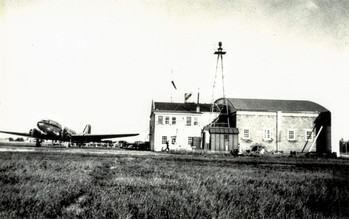



Time Flies: Sanderson Field Airport Through the Years
It wasn’t long after the Wright Brothers’ 1903 flight in Kitty Hawk, North Carolina that the novelty of air travel took off across the nation and made its way to the northernmost borders of Sault Ste. Marie, Michigan. Long before the present day airport — its paved runway, terminal, lights, and hangars — the Sault airport was pastoral scene, as described by one of the early pilots who honed their skills in the area: “There was nothing but a pole with a wind sock on an open dairy farm.”
With little regulation on air travel, the sky was quite literally the limit for many who wanted to learn the new art of aviation. Local pilots could learn how to fly at Ed Mattson and Harry Young’s flight school, where amateur licenses could be obtained for just $175. Aircraft could be rented at the airport for $7.50 per hour, and for only $2.50 more, a flight instructor would accompany. The Mattson Flying Service advertised “aero-plane rides” for only $1.00 in addition to flight instruction, as well as charter trips and sight-seeing trips.
After several years of operation as an unofficial airport used primarily by local pilots, the flight school, and the odd seasonal visitor who would fly in for summertime vacations, the airport was officially designated as an airport in 1934 under the Federal Emergency Relief Act (later to be named the Works Progress Administration) that was part of President Franklin D. Roosevelt’ New Deal program to revive the nation in the thick of The Great Depression. By the mid-1930s, the airport expanded to include three gravel runways, and in 1938, Pennsylvania Central Airlines began serving Sault Ste. Marie, connecting Sault Ste. Marie Municipal Airport to major cities east of the Mississippi through the 1960s.
Over the years, many improvements were made to the airport. The runways were widened, lengthened, and paved, and by the 1960’s, the gravel runways were phased out entirely. The present-day tee hangars were constructed in 2003, and the box hangar (a.k.a. the community hangar) was completed the following year.
In 1988, the Soo Pilots Association and Sault Ste. Marie City Commission made a resolution to amend the airport name to include “Sanderson Field” in honor of Creighton G. “Sandy” Sanderson. Born in Pickford in 1913, Sadnerson had a life-long love of flight that was instilled when he took his first airplane ride in an OX-5
powered Curtis JN4D at the age of nine. He received numerous accolades for his work during WWII, including the Distinguished Flying Cross, Presidential Citation, Air Medal with Cluster, 1328 ABU Meritorious Citation, S.W. Pacific Bar with Battle Stars, China Freedom Medal Order of Chaing Kai-shek, and Honorary Commission in the Republic of China Air Force with Command Pilot Wings.
Following the war, Sanderson served as President and Chief pilot for the Western Michigan Flying Service, and collaborated with Western Michigan University to develop a flight training program that foreran the school’s renowned College of Aviation, which today is the third largest in the county. He purchased the Chippewa Flying Service in 1950, and ran the business as the FBO through the early 70s, during which time he also worked as an FAA flight examiner. He was one of the first four individuals to be inducted into Michigan’s aviation hall of fame in 1987, and is additionally memorialized through the C.G. (Sandy) Sanderson Memorial Scholarship through the Lake Superior State University Foundation.

"Flight Between the Capitals of Industry" -- old timetables show flights that connected Sault Ste. Marie Municipal Airport to major cities throughout the East. Pennsylvania Central Airlines served the Sault from the 1930s through the 1960s.

Today, Sanderson Field oversees over 1,000 flight operations each year, ranging from corporate flights to customs flights, government and military flights (including the Coast Guard, Department of Defense, and National Guard), all the way to transient visitors and medevac flights. Throughout the years, the airport has seen notable passengers, including Morgan Freeman, Bruce Springsteen, and KISS. The 2018 Community Benefits Assessment, issued by the Michigan Department of Transportation - Office of Aeronautics, shows that through services offered and jobs provided,
Sanderson Field has a yearly economic impact that exceeds $1,000,000 for the city. The airport is managed by both the City of Sault Ste. Marie and a fixed-base operator, Great Circle Aviation Services, LLC. Through day-to-day operations and community engagement, Sanderson Field works to expand the city’s economic offerings, provide unique educational and recreational opportunities to individuals of all ages, and serve as a gateway to the Upper Peninsula and Ontario.
**Author's note: We are continuously striving to compile an accurate history of Sanderson Field Airport. If you have any additional information or insight on the airport, especially its earliest operations, please contact us at: gsmith@saultcity.com.
Creighton G. Sanderson (1913 - 1988), namesake of the airport.
Image source: The Michigan Aviation Hall of Fame

